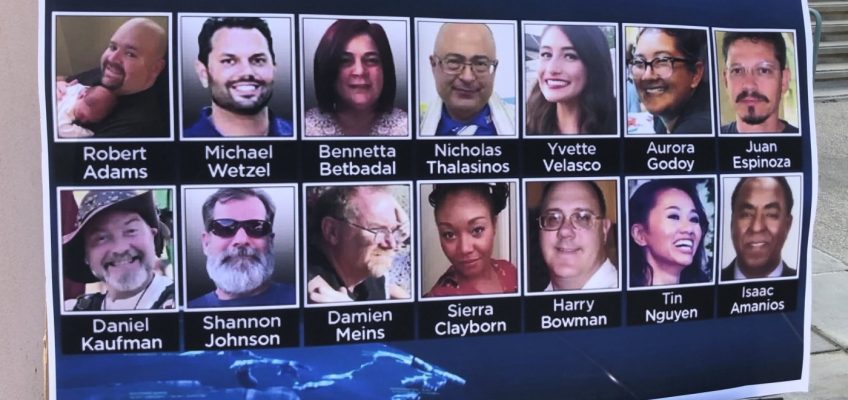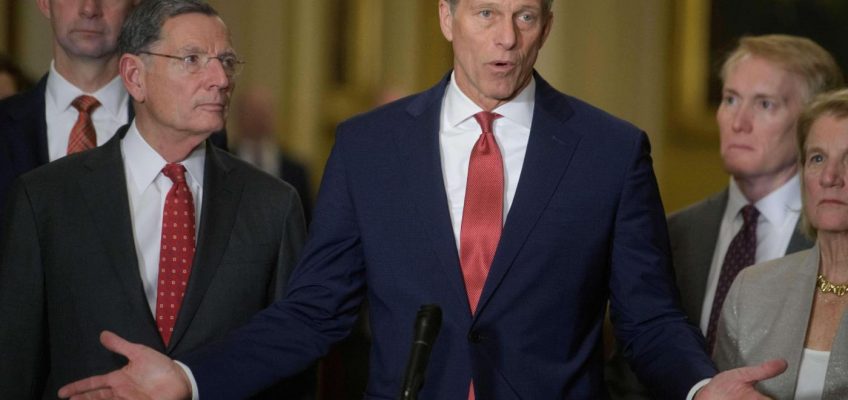The annual general education meeting started off normally.
In a rented conference room, San Bernardino County Division of Environmental Health Services employees ate from a breakfast buffet and competed for gift cards in a trivia game. Supervisors gave out awards and played instructional videos.
The meeting was “mandatory fun,” one person later told the FBI.
As staff gathered in front of a Christmas tree for group photos, one employee slipped outside. When he returned, he and his wife wore masks and carried semiautomatic weapons. They opened fire, murdering 14 people, including 13 of his coworkers, and wounding 22 more. The couple died in a shootout with police hours later.
The Dec. 2, 2015 mass shooting at the Inland Regional Center in San Bernardino was the 13th deadliest in American history.
San Bernardino attack: 10 years later
Why did the 2015 San Bernardino mass shooting happen?
10 years later, memories of San Bernardino terrorist attack still fresh
Scars, trauma remain 10 years after San Bernardino terrorist attack
Where to remember victims of 2015 San Bernardino terror attack
Here’s how the 2015 San Bernardino terror attack unfolded
In the decade since, a clearer picture of what led to the shooting has taken shape. Public records and interviews with those most directly affected suggest the San Bernardino mass shooting was both a terrorist act and a workplace shooting.
The attack was committed by a man who had grown up in an abusive home, was radicalized by violent online content, and who had access to high-powered weaponry. Family members of victims say workplace disputes that should have raised red flags were reported to the county.
“There’s always warning signs,” said Ryan Reyes. His partner, Daniel Kaufman, was killed in the attack.
‘Rage and despair’
Syed Rizwan Farook, the Environmental Health Services employee who would later open fire on his coworkers, was the son of Pakistani immigrants, born in Chicago but raised in Riverside.
It does not appear that it was a happy home.
Farook’s father was an alcoholic with bipolar disorder who refused to take prescribed medication, according to his mother.
A DMV photo shows Syed Rizwan Farook, who with his wife carried out a mass shooting at the Inland Regional Center in San Bernardino on Dec. 2, 2015. (Courtesy of California Department of Motor Vehicles)
“He is always mad. Drinking all day. Screaming on me, shouting at my kids for no reason,” Rafia Farook wrote in a 2006 request for a restraining order. “That day he tried to hit me. I do not know exactly why he was mad.”
Her children had to interpose themselves between their parents to stop their mother from being attacked, Rafia Farook wrote. Her husband would throw things, including dishes. He’d scream at the family and regularly threaten to kill himself. At least once, in February 2008, he was held in a county hospital for a 72-hour observation period, court documents show.
The couple divorced in early 2015.
According to the online mass shootings database The Violence Project, at least 70% of mass shooters have experienced significant childhood trauma.
“Parental suicide is common, as is physical abuse, sexual abuse, domestic violence in the home, and severe bullying by classmates,” the founders of The Violence Project, Jillian Peterson and James Densley, write in their 2021 book, “The Violence Project: How to Stop a Mass Shooting Epidemic.”
“This early exposure to violence and unaddressed trauma feeds the perpetrator’s rage and despair later in life,” the pair write. “Mental health concerns such as depression, anxiety, and paranoia commonly develop during adolescence and are rarely identified or treated.”
Syed Farook, a devout Muslim, fantasized about committing violence of his own, inspired by terrorist groups that claimed they fought on behalf of Islam. He eventually shared those fantasies with his neighbor, Enrique Marquez Jr., according to a 37-page criminal complaint filed by the FBI against Marquez in federal court two weeks after the attack.
Marquez had moved in next door to Farook’s family in 2004. Marquez, 14 at the time, hung out with Farook, then 18, while the older teen worked on cars in his driveway.
“Shortly thereafter, Farook introduced Marquez to radical Islamic ideology, which included expressing disdain toward Muslims in the U.S. military that killed other Muslims, and discussing the extremist views of the now-deceased imam and Islamic lecturer” Anwar al-Awlaki, the FBI’s complaint reads in part.
Farook and Marquez also read Inspire, the official online magazine of terrorist group al-Qaida, according to the complaint. The summer 2010 edition included instructions on how to build radio-controlled pipe bombs and called on readers to destroy the United States.
In 2011, the neighbors talked about attacks “designed to maximize the number of casualties,” according to the FBI complaint.
Maybe they could throw pipe bombs into the library or the cafeteria at Riverside City College.
Or maybe they could bomb the 91 Freeway during rush hour along a stretch near Corona that had few exits people could use to escape. Then Farook would move through the stopped cars, shooting trapped motorists, while Marquez shot first responders.
In November 2011 and February 2012, Marquez bought two AR-15 semiautomatic rifles. The day after the Inland Regional Center attack, he told a 911 dispatcher the guns had been used in the shooting in San Bernardino. Marquez later told the FBI the firearms were specifically bought to attack Riverside City College or the 91 Freeway. Separately, Farook bought two semiautomatic handguns.
In November 2012, the FBI arrested four Inland Empire men who had been plotting to join the Taliban and al-Qaida and kill or kidnap Americans overseas. Like Farook and Marquez, they had trained at Los Angeles-area paintball and gun ranges.
According to the criminal complaint against Marquez, the arrests spooked him. He pulled away from Farook and out of the plans to commit violence.
A San Bernardino County Sheriff’s Department photo shows the weapons police say were used in the mass shooting in San Bernardino on Dec. 2, 2015. (Courtesy of San Bernardino County Sheriff’s Department)
A new partner
But Farook seemed undeterred.
He began looking for a wife online. He matched with Tashfeen Malik, who was studying at a religious school in Pakistan.
The pair were “radicalized before they ever started courting or dating online,” then-FBI director James Comey told the Senate Judiciary Committee a week after the attack. “As early as 2013, they were speaking about jihad and martyrdom before they became engaged.”
After connecting via Skype, Farook and Malik finally met in person in October 2013, when he was on pilgrimage in Saudi Arabia. They got engaged the same day. In July 2014, Malik moved to the U.S. The couple later moved into a Redlands townhouse.
The pair had a baby girl six months before the mass shooting. They left her with Rafia on the morning of Dec. 2. They told the girl’s grandmother they had a doctor’s appointment. (Farook’s sister, Saira Khan, sought to adopt her niece after the shooting. The Riverside County Department of Public Social Services would not disclose where the child was placed, citing California’s confidentiality laws surrounding adoption.)
In a photo from U.S. Customs and Border Protection, Tashfeen Malik, left, and Syed Rizwan Farook move through customs at O’Hare International Airport in Chicago on July 27, 2014. Malik and Farook, the assailants in the deadly attack in San Bernardino, Calif., that killed 14 people last week, had been radicalized for a long time and had been practicing their aim at a target range just days before their murder spree, according to the Federal Bureau of Investigation. (Courtesy of U.S. Customs and Border Protection)
Malik practiced an extremely conservative form of Islam.
“(Redacted) asked to see a picture of his wife but Syed refused, explaining that she wears a religious head covering,” one of Farook’s coworkers said in an FBI interview. “Syed told (redacted) that he was still living with his family in Riverside. He explained that things were tense in the house, as his parents were not into the fact that his wife wore her head dressing ‘24/7,’ even in the house. Despite that, Syed said he was happy.”
Former San Bernardino Police Chief Jarrod Burguan told ABC News in 2016 that Malik had posted online that she did not believe Muslims should be required to participate in non-Muslim holiday events.
The environmental health services’ 2015 general education meeting was officially a training event, not a Christmas party. Employees told the FBI that past meetings had featured fall themes, with scarecrows and hay bales. And although past meetings had been mandatory, the 2015 meeting was not. But not all employees knew about the change, according to FBI interviews.
On the morning of the attack, as Farook and Malik drove to the Inland Regional Center, Malik searched social media for materials related to the terrorist group ISIS, according to the criminal complaint against Marquez.
As the couple fled after, she pledged the couple’s allegiance to ISIS leader Abu Bakr al-Baghdadi in a Facebook post.
Farook’s and Malik’s accounts were deleted by Facebook soon after.
Three days after the attack, ISIS called the pair “supporters” of the group in a radio broadcast.
In the end, the FBI ruled that Farook and Malik were homegrown terrorists.
“As of today, we do not see any indications of a foreign-directed terrorist act,” David Bowdich, Assistant Director in Charge of the FBI’s Los Angeles field office, said at a January 2016 news conference. Instead, the couple appeared to have been self-radicalized by online materials, like Inspire magazine and Anwar al-Awlaki’s speeches.
‘Should have known’
ISIS has urged the group’s followers to “direct your actions at the easy targets before the difficult, the civilian targets before the military, and the religious targets such as synagogues and churches before anything else,” as a spokesman said in a January 2024 speech.
But Farook and Malik didn’t choose a target with obvious political or religious significance. They targeted Farook’s coworkers.
Workplace shootings are the most common type of mass shooting. More than 29% of mass shootings in the Violence Project database are classified that way. That includes the attack at the Inland Regional Center, which the database also classifies as terrorism.
Farook worked as a health inspector for the environmental health services division for five years.
“Nothing at work gave (redacted) the impression that ‘this,’ meaning the shooting at the (Dec. 2 general education meeting), could happen,” an employee told the FBI in interviews after the attack. “Farook was a ‘typical’ employee; he did not stand out in any way.”
Farook’s coworkers never met Malik. But they threw a baby shower for the couple’s daughter months before the shooting.
Still, there were signs of trouble at work.
“Approximately three months ago, Farook’s demeanor changed,” a coworker told the FBI a week after the attack. Other interviewees made similar remarks. “He showed ‘no reaction at all’ when (redacted) greeted him. When (redacted) said ‘good morning’ or ‘hello’ to Farook, Farook would look at (redacted) but not respond in any way or acknowledge the greeting. (Redacted) would wonder to himself ‘did he hear me or what?’”
Farook also reportedly had a workplace conflict with at least one coworker.
“County knew that its employee Syed had a heated and volatile argument with a co-worker over the Islamic religion and faith,” an August 2017 claim filed on behalf of the relatives of three employees killed in the attack reads in part. “County knew or should have known that its employee Syed was predisposed to commit acts of violence and thus maintained a hostile work environment.”
Tina Meins, daughter of San Bernardino mass shooting victim Damian Meins, listens as her mother, Trenna Meins recalls the days before the Dec 2 shooting in San Bernardino, at Andulka Park in Riverside on Monday, Nov. 3, 2025. (Photo by Terry Pierson, The Press-Enterprise/SCNG)
Trenna Meins is the widow of Damian Meins, one of Farook’s coworkers who was killed at the Inland Regional Center.
In fall 2015, Trenna Meins was the principal of Sacred Heart Parish School in Rancho Cucamonga.
According to the county Department of Public Health, another of Farook’s coworkers, Nicholas Thalasinos, inspected the school’s kitchen on Oct. 8, 2015, less than two months before the San Bernardino attack.
“In our conversation about the kitchen, (Thalasinos) brought up the terrorist attack on the train in Paris,” Trenna Meins said, referring to the Aug. 21, 2015 shooting of four people on a train traveling from Amsterdam to Paris. Passengers subdued the gunman, who was linked to ISIS.
“And (Thalasinos) told me that he had a guy in his office, Farook, that defended the action of the terrorist,” Meins said. “So those two had an argument.”
Before his death in the attack, Thalasinos had a fiery online presence. Calling himself “ProTzionist” on his two Facebook accounts, he attacked those he saw as antisemites or enemies of Israel.
“The LIBERAL FASCISTS running America and Europe have this DELUSION that if they SACRIFICE INNOCENT JEWS on the PAGAN ALTER to the ADVERSARY and it’s Antisemetic CULT ISIS et al – the CULT will SPARE the LIBERALS,” he posted on his Michael Thalasinos account on Nov. 14, 2015.
Thalasinos’ widow declined to be interviewed for this story. His brother was one of the plaintiffs in the August 2017 claim against the county.
A week or so after meeting Thalasinos, Meins said, her husband mentioned Farook to her.
“He said he thought somebody got fired,” she said.
According to Meins, her husband told her Farook was escorted out of the office and didn’t return the next day.
“And then one day, I can’t tell you how long, but Damian said (Farook) was back. I want to say he was gone three days,” Meins said. “(Damian) talked a bit about this conflict that Farook had in the office with people.”
Rafia Farook, mother of 2015 San Bernardino shooter Syed Rizwan Farook, leaves U.S. District Court in Riverside on Feb. 11, 2021, after her sentencing for destroying evidence. (File photo by Watchara Phomicinda, The Press-Enterprise/SCNG)
After the shooting, Farook’s mother, Rafia, shredded attack plans apparently drawn up by Farook and Tashfeen. The plans included a hand-drawn map of the Inland Regional Center conference room noting where the managers would be sitting. Witnesses told the FBI that Farook and Tashfeen appeared to be shooting at the managers’ table on the far side of the conference room. In February 2021, Rafia was sentenced to six months of house arrest and three years of probation after pleading guilty to a single charge of destroying evidence.
According to Reyes, whose partner Kaufman worked at the Inland Regional Center and was the only non-county employee killed in the attack, FBI agents told victims’ families that religious arguments involving Farook were reported to the county’s human resources department.
“I will never forgive the county for not doing their (part) and responding as they should have as far as preventing” the attack, Reyes said.
Former San Bernardino County Supervisor Janice Rutherford tears up Friday, Oct. 3, 2025, while discussing the Dec. 2, 2015, mass shooting during an interview in Rancho Cucamonga. (Photo by Terry Pierson, The Press-Enterprise/SCNG)
Janice Rutherford, who was on the San Bernardino County Board of Supervisors at the time of the attack, accepts the anger some have toward the county.
She recalled advice that county leadership got from Rudy Guiliani, who was mayor of New York City during the Sept. 11, 2001 terrorist attacks. “He said ‘the anger has to have some place to go,’” Rutherford said. “Anger is part of the grief response and it is a rational response to the tragedy that has occurred. But the terrorist is dead, the terrorists are dead. The organization or cause to which they pledged themselves is this abstract, distant, obscure (thing) you can only be angry at in a metaphysical sense.”
But county government is still there.
“‘The victims and the families have to have someone to be angry with and they’re going to be angry at the county,’” she said, quoting Guiliani. County officials decided to accept that anger. “We would be that target. We will not fight back. We will not criticize. We will not complain,” Rutherford said. “We will just do it. We will just take it.”
According to the Meins family, victims’ families have tried for years to get access to Farook’s personnel file. San Bernardino County has refused to release the file, citing Farook’s privacy rights.
On Nov. 18, the county released Farook’s performance reviews in response to a California Public Records Act request from the Southern California News Group. According to the county, there were no records in his file related to workplace incidents or a heated argument regarding Islam with a coworker. The only disciplinary notice was a 2014 warning that Farook was using too much sick leave.
According to San Bernardino County spokesperson David Wert, if a workplace argument regarding religion had occurred, that would not necessarily have suggested violence would result and would have been handled by a supervisor without formal write-ups in the employee’s personnel record.
“The county would have taken swift and decisive action in response to any employee who posed a threat to fellow employees or the public,” Wert said.
Legal actions against the county related to the mass shooting appear to have all fizzled out or were withdrawn. The only settlement the county has made public is a $140,000 settlement with a motorist struck by a sheriff’s deputy’s vehicle.
Former San Bernardino County CEO Greg Devereaux, seen Friday, Sept. 26, 2025, in Ontario, still struggles with emotions from his memories of the 2015 San Bernardino mass shooting. (Photo by Terry Pierson, The Press-Enterprise/SCNG)
Senior San Bernardino County officials said they never investigated if there were red flags in Farook’s personnel file the county had missed.
“We didn’t worry about ‘why,’” former San Bernardino County CEO Greg Devereaux said. “We had a county that had to keep functioning. And we had to take care of the employees and their families.”
To Rutherford, the shooting was terrorism.
“These people came to work on an ordinary day to do an ordinary job as county employees and ending up giving their lives, having their lives taken for … we don’t completely know,” she said. “I believe it was because of the terrorist intentions that (Farook) stated. And it can happen to anybody on any day.”
Increased security at county facilities is discussed in the county’s 205-page organizational review of its response to the mass shooting, published in 2018. The measures included adding more security cameras and remote-locking doors.
“Once we understood the nature of the event, it was likely there is no more risk from that day on than there had been for decades,” Devereaux said. “But that’s not how the employees felt.”
The report doesn’t discuss procedures to flag dangerous employees before tragedy occurs.
‘That’s half of the room’
On the day of the attack, shooting Farook’s coworkers may have been the back-up plan.
“At approximately 10:30 a.m. PST, during a presentation, possibly during the ‘Two Truths and a Lie’ game, (redacted) observed Farook exit the room through the glass doors closer to the management table which exit to the east parking lot,” an environmental health services employee told the FBI.
Farook left behind a black bag with three long cylindrical items inside: radio-controlled pipe bombs. The bombs were built using explosive powder Marquez had bought years before, according to the criminal complaint against him. Investigators believe Farook and Malik learned how to make the bombs online.
But the bombs didn’t go off. Investigators have speculated the bombs may have been intended to kill first responders, similar to the 91 Freeway attack plan.
Farook and Malik returned from the parking lot and opened fire with semiautomatic rifles, one of which they had tried to modify to turn into an automatic weapon, according to the Bureau of Alcohol, Tobacco, Firearms and Explosives.
“In any kind of mass shooting that there’s been when they’ve had those types of weapons, you see higher (numbers of) people who are wounded or deceased,” said Damian Meins’ daughter, Tina.
After the mass shooting, Tina Meins joined Everytown Survivor Network, a branch of Everytown for Gun Safety, a nonprofit advocating for strong gun control. She’s testified before Congress about the need for stronger gun laws.
The Meinses say if Farook and Mailk hadn’t had semi-automatic weapons, things might have been different.
“Even if my dad was still not going to make it out, perhaps we wouldn’t have had dozens wounded that are still living with the ramifications of those injuries still today,” Tina Meins said.
“There were 72 people in the room. And 36 of them were injured or killed,” Trenna Meins said. “That’s half of the room.”
In October 2020, Marquez was sentenced to 20 years in prison for conspiracy to commit terrorist acts and for making false statements when he acquired the rifles used in the Inland Regional Center shooting.
A courtroom sketch from Dec. 17, 2015, shows Enrique Marquez appearing in federal court in Riverside. (Bill Robles via AP, File)
‘You don’t know’
On Dec. 2 each year since 2015, mourners have gathered at memorials outside county headquarters and at Cal State San Bernardino to remember the dead.
“It’s not just the families — the immediate families — that are suffering through this,” Trenna Meins said. “It’s the other families, the cousins, the uncles. It’s friends. It’s communities.”
Family and friends watch Saturday, Dec. 2, 2023, as Cal State San Bernardino professor Michael Nguyen rings the bell in the Peace Garden 14 times to honor each of the 14 people killed in the Dec. 2, 2015, terrorist attack. (File photo by Terry Pierson, The Press-Enterprise/SCNG)
Childhood trauma. Online radicalization. Problems at work. None of these, alone or together, fully explains why Farook and his wife committed mass murder.
“Many of the factors correlated with mass shootings, from childhood trauma to gun ownership, are true for millions of people who never commit mass shootings,” Peterson and Densley write in their Violence Project book.
There have been at least 195 mass shootings in the United States since Dec. 2, 2015, causing the deaths of 1,398 people, according to the Violence Project database.
“It makes you wonder,” Rutherford said. “Can you ever truly know another person? Can you ever truly trust another person? We all think that we’ve got these antenna that can tell exactly someone’s intentions and motives. You can’t. You don’t know.”
Staff writer Jeff Horseman contributed to this report.
Note: This story has been updated to clarify details about Enrique Marquez’s conviction on criminal charges.
More about the San Bernardino mass shooting
Feds arrest four Inland Empire men in terrorism plot
Terrorism suspects may have trained at Chino paintball facility featuring simulated Middle Eastern cities
American heroes who foiled Paris train attack to be honored at Lakers game
14 dead, 21 injured in San Bernardino mass shooting; 2 suspects killed
Source: San Bernardino mass shooter Syed Farook had photos of a Rialto high school on cellphone
In frantic 9-1-1 call, shooter’s friend reveals gun was his, according to complaint
A year later, normalcy returns to Redlands neighborhood of San Bernardino terrorists
A look back at the victims of the San Bernardino terror attack
Peace garden at Cal State San Bernardino dedicated to Dec. 2 terror attack victims
20 years for man who supplied guns in San Bernardino mass shooting
FBI reassembles shredded plan for 2015 San Bernardino terrorist shooting
San Bernardino terrorist’s mother, who destroyed attack plan, is sentenced to house arrest
Memorial for victims of San Bernardino terror attack opens Monday, here’s what it looks like
10 years later, memories of San Bernardino terrorist attack still fresh
Scars, trauma remain 10 years after San Bernardino terrorist attack
Here’s how the 2015 San Bernardino terror attack unfolded
Where to remember victims of 2015 San Bernardino terror attack




